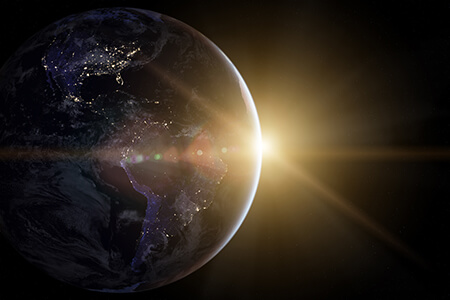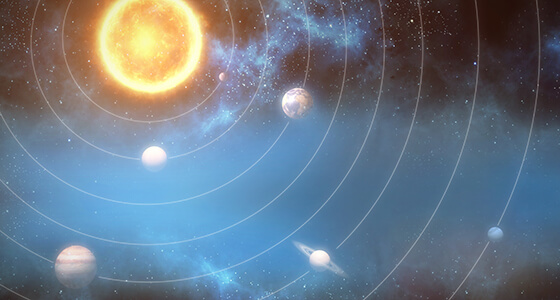This is a lesson summary. The full lesson can be viewed by purchasing an online course subscription.
Learning Objective
In this lesson we will learn about the components of our solar system and how planets move through the solar system.
Learning Outcomes
By the end of this lesson you will be able to:
- Compare the geocentric and heliocentric models of the solar system.
- Define ‘planet’, ‘moon’ and ‘asteroid’.
- Describe the planets of the inner and outer solar system.
- Describe the asteroid belt and Kuiper belt.
- Describe the two types of planetary motion and explain how they relate to day length and year length.
- Describe planetary orbits and define the terms ‘ecliptic plane’, ‘perihelion’ and ‘aphelion’.
- Explain what astronomical units are.

(Image: Paopano, Adobe Stock)
Lesson Summary
- Historically it was believed that the sun, moon and planets all orbited the Earth. This is known as the geocentric model of the solar system.
- The geocentric model has been replaced by the heliocentric model of the solar system, in which the Earth and other planets orbit the sun.
- Our solar system includes the sun, which is orbited by the planets, which are in turn orbited by moons. It also consists of other bodies, such as asteroids and comets.
- The inner solar system consists of the terrestrial planets – Mercury, Venus, Earth and Mars – and the asteroid belt.
- Terrestrial planets are smaller, composed primarily of rock or metal, and lack ring systems.
- The asteroid belt is a donut-shaped region between the orbits of Mars and Jupiter that contains approximately one million asteroids – small rocky object that orbit the sun.
- The outer solar system consists of the giant planets – Jupiter, Saturn, Uranus and Neptune – and the Kuiper belt.
- Giant planets are larger, composed primarily of hydrogen and helium or water, ammonia and methane, and possess ring systems.
- The Kuiper belt is a donut-shaped region outside the orbit of Neptune that consists of millions of icy objects that orbit the sun.
- A planet is a celestial body that:
- Orbits the sun.
- Has a spherical shape, due to the gravity resulting from its large size.
- Has no objects of a similar size near its orbit.
- A moon is a celestial body that orbits around a planet.
- The terrestrial planets have few or no moons.
- The giant planets have many moons.
- Planets move in two ways:
- They move in a path around the sun known as an orbit.
- They rotate on their axis – an imaginary line joining the north and south poles.
- The time taken for a planet to orbit the sun is known as a year.
- A year on Earth is approximately 365 days.
- The further a planet is from the sun, the longer its year, due to having a larger orbit and a slower orbital speed.
- The time taken for a planet to rotate on its axis is known as a day.
- A day on Earth is approximately 24 hours.
- The day length of a planet is largely determined by the rotational speed when the planet was formed.
- All of the planets orbit the sun on an imaginary flat surface called the ecliptic plane.
- Planetary orbits are slightly elliptical, meaning the distance from the sun varies.
- The point where a planet is closest to the sun is called the perihelion.
- The point where a planet is furthest from the sun is called the aphelion.
- Earth’s average distance from the sun is approximately 150 million km.
- This distance is known as an astronomical unit.

(Image: vectorfusionart, Adobe Stock)
(Header image: Alexandru, Adobe Stock)
